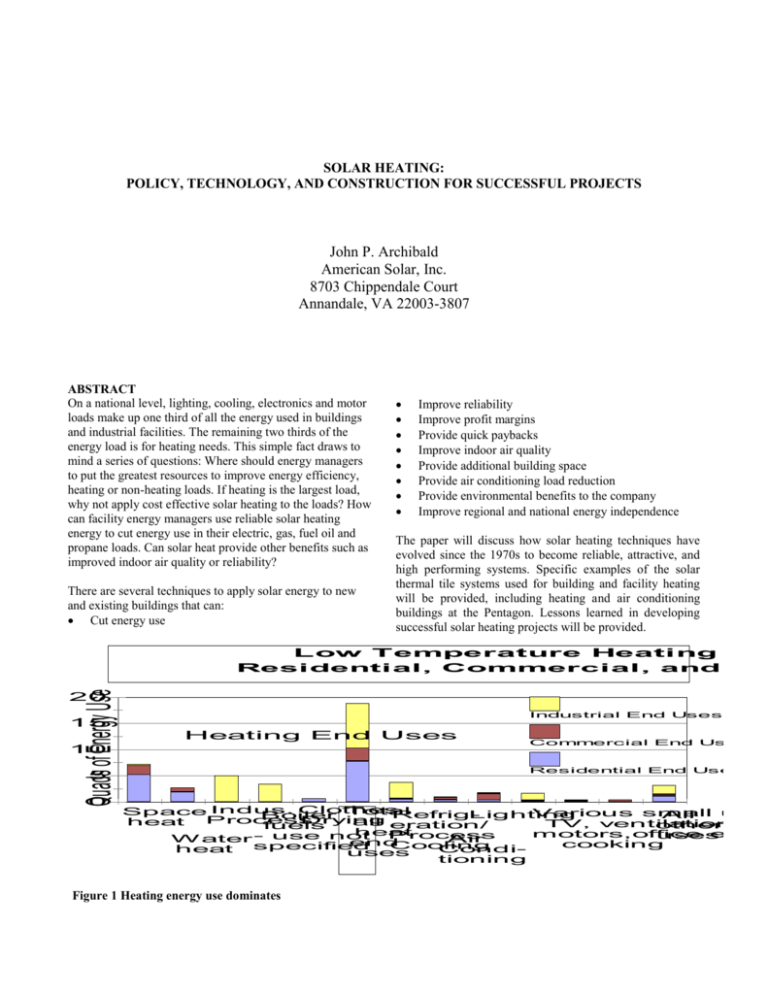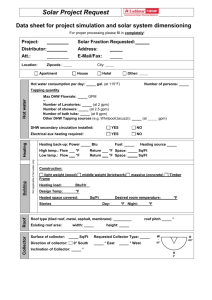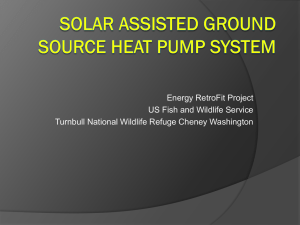design and construction of solar thermal tile
advertisement

SOLAR HEATING: POLICY, TECHNOLOGY, AND CONSTRUCTION FOR SUCCESSFUL PROJECTS John P. Archibald American Solar, Inc. 8703 Chippendale Court Annandale, VA 22003-3807 ABSTRACT On a national level, lighting, cooling, electronics and motor loads make up one third of all the energy used in buildings and industrial facilities. The remaining two thirds of the energy load is for heating needs. This simple fact draws to mind a series of questions: Where should energy managers to put the greatest resources to improve energy efficiency, heating or non-heating loads. If heating is the largest load, why not apply cost effective solar heating to the loads? How can facility energy managers use reliable solar heating energy to cut energy use in their electric, gas, fuel oil and propane loads. Can solar heat provide other benefits such as improved indoor air quality or reliability? There are several techniques to apply solar energy to new and existing buildings that can: Cut energy use Improve reliability Improve profit margins Provide quick paybacks Improve indoor air quality Provide additional building space Provide air conditioning load reduction Provide environmental benefits to the company Improve regional and national energy independence The paper will discuss how solar heating techniques have evolved since the 1970s to become reliable, attractive, and high performing systems. Specific examples of the solar thermal tile systems used for building and facility heating will be provided, including heating and air conditioning buildings at the Pentagon. Lessons learned in developing successful solar heating projects will be provided. Quads of Energy Use Low Temperature Heati ng Do Resi denti al , Commerci al , and Ind 20 Industrial End Uses 15 Heating End Uses 10 Residential End Uses 5 0 Commercial End Uses Clothes Total Space Indus. Various small use RefrigLighting All Boiler Drying Process all eration/ heat TV, ventilation, other fuels heat motors,office equip Process uses Air W ater - use not end cooking Cooling specified Condiheat uses tioning Figure 1 Heating energy use dominates HEATING NEEDS DOMINATE BUILDING AND INDUSTRIAL ENERGY USE Approximately 60% of all residential, commercial, and industrial energy use in the US is for heating buildings and industrial processes. See Figure 1. This onsite use of energy is most often provided by conventional heating technology such as burning natural gas, fuel oil, or propane, or by electric resistance or heat pump heating equipment. The largest single energy use is for space heating, followed by water heating, then process heating. Space Heating Building space heating for occupant comfort is essentially an air heating load, where the goal is to provide warm air next to the inhabitants. Solar air heating systems hold promise to satisfy this energy demand without the conversion losses often associated with more conventional heating sources. See Figure 2. Often these conversion losses from conventional heating technologies involve the use of different heating media, such as water heating in boilers, as an intermediate process in hydronic based radiator or radiant floor heating systems. Fuel is burned, to heat water, to heat air next to the inhabitants. Energy Delivered / Energy Consumed Sola r Heating System Energy De livery 3 to 4 times more energy delivered than f rom highest ef f iciency f ossil/electric systems 4 If electric heating energy is considered, a low 30%-40% power plant conversion efficiency must also be taken into account. If electric resistance heat is used, the true energy delivery for space heating may be on the order of 20% to 25% of the energy burned at the power plant. When heat pumps are used for space heating, they extract heat from “sun warmed local air” to double or triple the productivity achieved by electric resistance heat. Even so, heat pumps only achieve about a 60% conversion efficiency compared to the energy consumed at the power plant. Poor off peak performance during weather below 60 degrees F drops overall heat pump efficiency down to below 50% in many moderately cold climates. In comparison, solar heating technologies, both air and water heating, deliver between 10 and 30 times as much heat energy as they consume to run fans or pumps. Even when energy losses from the power plant and building distribution systems are considered, the performance of solar heating systems is between 3 and 12 times higher than conventional sources. If air heating is required, solar air heating technologies are often the most productive and least expensive energy conversion technologies compared to the energy consumed in the process. hi gh e ffi ci ency 3 norm a l effi ci ency 2 1 0 occupied spaces, and boiler or heater radiation losses at low firing rates can reduce heating system efficiency within the building to less than 50% when measuring the actual energy consumed vs. energy delivered. Electric Oil & Gas Electric Heat Furnace Resistance & Pump Water Heat Heater Energy Solar Heat Data S ources: Int'l Agency, PNNL, NREL Figure 2 Solar heating vs. conventional heating efficiency Where water based systems are used for space heating, the most visible conversion of energy is at the boiler or water heater. At this equipment, the fuel is often visibly burned and in many cases gas or electric meters may measure “energy” consumption. However, “energy consumption” measured at the burner is often twice the amount of energy required simply to heat air in the occupied spaces. Exhaust losses up the stack, line losses from the heated water pipes running through unconditioned spaces, duct losses from air escaping in the middle of the run, excessive heating of building envelopes from radiators or radiant floors, excessive stratification of heat between ceiling and floor in Water heating If water heating is all that is required, usually solar water heating technologies are the most productive energy conversion method. Usually, the conversion from solar heated water-to-air or air-to-water adds cost and reduces productivity. Conversion, via thermal storage, to match the timing of energy supply with energy demand throughout the day, will also reduce efficiency and increase cost. Despite the technical capability of a particular solar technology at meeting an apparent demand, such as solar water heating for hydronic space heating, often a simpler solution, direct air heating, is a more productive and less costly approach. However, when solar air heating is installed for winter space heating, a small additional expense can fund the installation of solar air to water heating components for year round water heating. Usually water heating systems are only sized to meet the daily water heating load, which is much smaller than the space heating load. Adding capacity to the solar water heating system can provide some space heating capability, but it is generally more expensive than adding a solar air heating system. Industrial Heating For industrial energy use, process heating and facility space heating consume nearly twice as much energy as all other industrial uses combined. The loads include an enormous variety of processes from; drying of lumber, textiles, and paper, to dehydrating air for pharmaceutical and candy production, to boiling water for canning foods and sterilizing production facilities. In many industrial applications, intermediate heating media are used to achieve a desired heating effect, e.g., water is boiled to steam to heat air to dry products. Diesel Generator Standby Heating One particular industrial heating application is the standby heating of emergency diesel generators. Diesel engines rely on the heat of compression of air in the cylinders to reach the ignition temperature of the injected diesel fuel. In warm climates, the engines and the outside air will usually be warm enough to allow the compression to achieve fuel ignition. However, in most US climate zones, cold outside air exists for enough hours of the year that ignition can not be guaranteed. In these colder climates, both the engine and the combustion air may need to be heated to guarantee year round cold starts. While air in the cylinders is what needs to be heated, a convenient, but high cost approach to providing this heated air is to use an intermediate fluid, the cooling water that “jackets” the cylinders of the engine (jacket water). The most common approach is to install electric heaters in the jacket water circuit. These heaters are typically electric resistance type cartridge heaters. For large engines, (>1,500 KW) the fluid may be pumped through the engine. For small and mid sized engines, the heater is usually set up in a convection loop beside the engine. Heating of the jacket water in the cartridge heater causes it to rise up in the cylindrical cartridge and flow out through a pipe connected near the top of the engine. Within the engine, this warm water flows through the cylinder jackets to a pipe connected near the bottom of the engine, and then back to the bottom of the cartridge heater. Typically these heaters are set to maintain 130 degree F water temperature leaving the heater. Water returning from the engine is typically about 120 F. Even with the system properly installed, the engine is not evenly heated. Typically, the engine “block” will show increasing temperatures from bottom to top, with the bottom of the engine at ambient temperatures as low as O degrees F in cold climates and the top of the engine at 80 to 90 F. Similarly, the engine temperature decreases rapidly with increasing horizontal separation from the heater supply and return lines. In general, the heaters seem to be sized at about 1 KW of heater capacity for each 100 KW of engine capacity. The heaters may only operate at their rated capacity during the coldest winter conditions. However, the electricity use during warm summer conditions can still be quite high, at several KW during 70 degree weather. Annual energy consumption for mid sized generators will be about 17,000 kilowatt hours per year in moderate climates. In some generator enclosures, additional heaters are also installed for fuel tanks and fuel lines, for space heating, and for battery heating. Where such heaters are installed in outdoor enclosures, annual heating loads can easily exceed 25,000 kWhr/yr. The heating elements may cost only a few hundred dollars to install, but cost thousands of dollars per year to run. --- Over the life of the generator, the heating energy costs may add 50% to 60% to the installed cost of the system. While jacket water heating is almost universal, air heating can actually be less expensive and more productive. Air heating provides: both a heated engine and heated combustion air, more even heating of the engine, greater thermal storage in the mass of the engine and generator and enclosure to better respond to temperature changes, heating of the fuel and battery systems, and heating of the operating fluids such as oil in the sump which improves lubrication during startup. SOLAR HEATING PROJECTS AT THE PENTAGON The Pentagon Reservation contains several buildings that support the operation of the main building and other agencies in the Washington, DC area. One of the buildings operates a loading dock for the receipt of materials. A nearby building supports an emergency generator to provide backup power in the event of a power outage. The following sections discuss two successful projects installed to provide solar air heating of the space and equipment. SOLAR SPACE HEATING OF A LOADING DOCK One of the buildings at the Pentagon operates a loading dock for the receipt of materials, primarily during early morning through the afternoon. Trucks back to the two overhead roller doors to discharge materials. To the sides of the roller doors are air intake louvers which permit air flow through the loading dock as a supply air source to the industrial process within the building. Even with the loading dock doors closed, outside air can flow through the loading dock via the louvers. Despite the use of loading dock door seals, winter time operations are at close to outdoor ambient temperatures. Figure 3 Solar Thermal Tile System To improve operating temperatures, overhead, gas fired unit heaters are installed. Operators complain that the exhaust from the overhead unit heaters is very localized at the center of each roller door, and is too hot when working off the back of a truck bed. The Pentagon Energy Office has contracted for the installation of solar thermal tile air heating system on the roof of the building (See Figures 3 and 4). The solar thermal tile system is an evolutionary solar heating system that improves on the air heating systems developed in the 1970s. Unlike the old style flat plate collectors, the solar tile system combines solar heating and roofing technologies to create an aesthetically pleasing, cost effective heating and roofing system. The use of solar air heating, instead of the more well known solar water heating systems, fits well with a number of heating and cooling needs including; space heating, heat pump heating, boiler air heating, and desiccant air conditioning. The solar heated air from the loading dock system is delivered to the work area at the center of each loading dock door. Excess heated air at the top of the loading dock will be returned to the solar roof for re-heating and re-delivery to the dock doors. To provide solar heat during the early morning hours, the solar air heating system incorporates water thermal storage. The water tank is heated via a hybrid system using solar heated air from the solar tile system and waste heat from the industrial process within the building. Hot air from the solar tile system heats the water in a coil in the air handler. The hot water is circulated to the storage tank during sunny weather. Hot water is drawn from the tank to the coil in the air handler when solar hot air heating is not available in the early morning or on cloudy days. A separate water to water heat exchanger has been designed into the system to circulate hot water to the tank from the industrial process. This hybrid system will increase the availability of stored heat in the tank even when solar heating is limited. The system has been designed with a larger tank capacity than required for thermal storage from the solar roof. This larger capacity has incorporated to accommodate a second available source of heat from an industrial process within the building. The solar heating system will heat 130 to 170 gallons. The full 530 gallon capacity will be used when the heat recovery system is installed. Issues of funding for the second heating source have delayed the installation of the heat recovery system. In the meantime, the system is operated at reduced volume to ensure adequate temperatures are maintained in the thermal storage tanks. Figure 4 Solar Tile System Installed The solar thermal roof is installed on a section of south facing roof adjacent to the loading dock. The roof consists of 100 square feet of ‘Classic Slate’ solar tiles installed over corrugated metal absorbers. Air moving under the tiles is drawn into the building from a plenum at the east end of the roof section. Return air from the building is ducted along the top of the roof to a plenum at the west end. Supply and return air ducts penetrate the exterior wall of the loading dock above the roller doors. The air handler inside the loading dock includes three equally sized in-line fans and 4 backdraft dampers to control air flow. The fans are rated at 100 CFM at 1” static pressure. They are designed to move 1 to 2 CFM per square foot of solar tile roof. Each fan consumes only about 80 watts of power. In comparison, the system delivers about 2,900 watts (10,000 BTU/hr) of peak heating thermal energy. The supply fan draws air from the solar roof, and exhausts across the water heating coils. The return fan sends the coil exhaust air back to the solar tile system for re-heating. Water is constantly pumped through the coils to store solar heat in two 265 gallon water tanks. In the early morning, the tanks deliver heat to the coils. By early-morning, the solar roof supply fan is delivering heat to the coils for storage in the tanks. The door fan draws air from the return plenum, downstream of the water coils, to feed the warm air ducts around the loading dock doors. When the supply and return fans are not running, the door fan draws air from the room, across the hot water coils. If the door fan calls for heat while the solar supply and return fan are running, the door fan will draw air from both the solar supply fan and the room, across the hot water coils. The use of spring loaded backdraft dampers balances pressures across the fans and coils ensures air flow from the intended source with minimal controls. SOLAR HEATING OF AN EMERGENCY GENERATOR Reliable electrical power is essential to ensure safe operation of the industrial equipment inside the building. As a result, an emergency generator is installed in an outdoor enclosure adjacent to a small storage building. The shed roof of the storage building faces south at a slope of 4 in 12. The generator is located about 4 feet from the north side of the building. The Pentagon Energy Office contracted for the installation of an emergency generator solar heating system. The system incorporates 100 square feet of Classic Slate Solar Tiles installed on 6 foot wide by 17 foot tall section of the shed roof. The solar tile system is the weather tight roof of the building. Supply and return ducts from the roof are enclosed in a vertical trunk on the north side of the building down to a fan enclosure near the generator. Solar heated air is drawn from the solar roof down to a single fan in an enclosure on the north side of the building. The fan is rated at 150 cfm at .75 inch water static pressure for the supply and 79 cfm at .5 inch water for the return. Supply fan running power use is about 53 watts. The solar heated air is blown about 3 feet across to the generator enclosure, in a trunk above ground. The solar heated air is discharged directly under the diesel engine. Warm air from the upper part of the generator enclosure is drawn back to the roof by a return fan. The return fan takes this air to the bottom of the roof and discharges it into a plenum on the lower half of the roof. The generator enclosure provides very little containment of heated air due to the ventilation openings on all doors and the elevation above the foundation slab of the entire generator skid and enclosure on shock dampers. STRUCTURAL INTEGRATION WITH THE BUILDINGS Both solar roofs are attached to the main structural walls of the building and rest on top of the existing standing seam metal roofs. In the case of the storage building, the structural members that tie the roof to the walls, actually penetrate the existing roof to attach to the walls. The Figure 5 Emergency Generator Solar Heating Schematic weather tight solar tile roof completely covers the old existing roof from ridge to eaves so the structural openings are of no consequence to the weather integrity of the building. In the case of the industrial building, the solar tile roof floats over the existing standing seam roof, with no penetration of the weather tight envelope. In this case, rainwater and snow melt flow under the solar tile roof. INITIAL OPERATIONS The Emergency Generator System began operation in February of 2003. The Loading Dock system began operation in April of 2003. Both systems are working within specs to deliver solar heated air to the loads. Shortly after completion of the exterior portions of the solar tile systems, the Washington DC area experienced the 5 th largest snowstorm ever recorded. Approximately 18” of snow fell over a 2 day storm. Snow accumulated on both roofs. Within 36 hours, the snow slid off of the storage building solar roof. The system turned on under automatic control on the first partly sunny day following the storm. the solar air duct below the generator and jacket water and ambient temperatures. On the industrial building, the snow also accumulated on the solar tile system as well as on the 50 foot slope of the standing seam metal roof above the solar tile system. Over the next several days snow banked up above the solar tile roof and very gradually slid up and over the solar tile roof section. Melting snow continued to flow, in accordance with the design, under the solar tile system on the existing metal roof. After a week, there was no damage to any of the structure, tiles, or trim. There was no impact on the systems performance when operation began in April. During the beginning of this period, the ambient temperature varied between 50F and 25F. The power draw on the heater cycled between full on and full off. Peak current was 13.8 amps. Average hourly current for the heater varied between 8.5 amps and 12.5 amps. Only during the weekly 30 minute generator tests did the current draw drop below this range as the engine achieved normal operating temperatures. The electric current rises and falls in opposition to supply temperatures from the solar tile system. MONITORING PERFORMANCE The return water temperature to the electric cartridge heater Figure 6 Solar heat vs. generator heater current remained between 92 and 80 degrees F with occasional excursions up to 109 F during the engine tests. The return water temperature varied as the ambient temperature varied. In contrast, the temperature of the water hose at the top of the radiator varied in opposition to the ambient temperature changes. This occurred because the colder ambient temperatures caused an increase in heater average power, The Emergency Generator system was monitored from January through April. See Figure 6. A current meter was placed on the 115Volt AC line at the circuit breaker feeding the combined electric cartridge heater and the battery charger. Temperature data loggers were installed to monitor which increased the temperature of the water at the top of the jacket water circuit, which is the top of the radiator. In February, the solar tile system for the emergency generator typically begins automatic operation of the fans, on a clear sunny day at about 10 AM. It continues to run until about 6PM, providing 8 hours of collection with a differential thermostat setting of 16 degrees between the roof temperature and the sensor strapped on the top of the radiator hose. Mid day temperatures of the air discharged from the duct below the diesel engine were 40+ degrees F above the ambient temperature at the generator corresponding to an approximate 150 CFM of air flow. Maximum temperatures during early spring testing were around 120 F. These temperatures were achieved before any improvements were made to fan air flow and with no insulation of the fans or supply and return ducts in the fan enclosures. Both adjustments are planned before final turnover of the system. The modifications are expected to increase temperatures to about 50 to 60 F above ambient, leading to peak summer temperatures in the preferred range of 140-160F. An additional modification of the duct work will be tested to determine the effect of converting the return air path to a second supply air path. Since the generator enclosure provides little containment of the warm solar heated air at the top of the enclosure, the return air temperatures are close to ambient and provide little temperature boost when delivered back to the solar roof. An alternative approach is to reverse the flow in the return air duct and use a single supply fan for both ducts. This will reduce the air flow rate over the collector and boost delivered air temperatures for the same air volume flow. Expected air temperatures with the revised duct configuration are in the range of 65 to 75 F above ambient. Solar Thermal Tile Systems can generate heated air at temperatures as high as 100 degrees F above ambient temperatures and in most climates the maximum air temperature can reach 200 degrees F on a hot summer day. RECENT DEVELOPMENTS The Pentagon Energy Office has recently contracted for the installation of a solar thermal tile system that will use solar heated air to heat and cool a guard station. This will be the first deployment of a new solar air conditioning system which uses solar heated air and desiccant and evaporative cooling to deliver cool dry air from a solar roof. CONCLUSIONS Diesel electric heater energy use is proven to vary with outside ambient temperature. Solar air heating of the enclosures can raise the temperature directly adjacent to the diesel engine and within the enclosure and cut diesel electric heater use. Solar thermal tile air heating systems are currently delivering solar heated air to emergency generators. The solar thermal tile system has been demonstrated to provide a weather tight “solar roof” over a storage building and provide solar heated air to an adjacent emergency generator. Solar thermal roofing technology has been designed and installed and is providing space heating for a loading dock. Solar thermal storage via air to water heat exchange and water storage have been installed and demonstrated. A hybrid thermal storage system using heat recovery from industrial process has been designed into the installed system. Solar thermal tile system operation immediately after significant snowstorms has been demonstrated. REFERENCES 1. American Solar, Inc. analysis of US Department of Energy, Energy Information Administration data from Residential Energy Consumption Survey, Commercial Building Energy Consumption Survey and Manufacturing Consumption of Energy. 2. Archibald, J.P., 1999, Building Integrated Solar Thermal Roofing, Solar 99 Conference Proceedings of the ASES Annual Conference 3. Archibald, J.P., 2001, Design And Construction Of Solar Thermal Tile Systems For Stand-By Heating Of Emergency Diesel Generators, Forum 2001Proceedings of the ASES Annual Conference ACKNOWLEDGMENT The author would like to acknowledge the support of the Pentagon Energy Office and Defense Protective Service during the construction and initial operation of these solar thermal tile systems.






